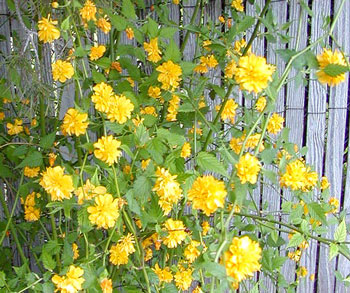Japanese Rose or Kerria Rose
Kerria japonica 'Pleniflora'
… for a filigreed cascade of golden blooms

Common Names: Japanese Rose or Kerria Rose
Latin Name: Kerria japonica 'Pleniflora'
Design Tips: In the border, it can be planted next to deciduous garden trees, such as white-flowering Crape Myrtle, and encouraged to ramble up thru the limbs. Its lack of thorns suits formal training up an arbor or rose arch frame. When left to grow untrained, the cascading habit and green stems add a filigreed elegance to naturalized settings. This is one of those no-fail plants with a dozen uses, but the brilliant golden bloom color requires careful placement, to avoid clashing against pastel shades.
Size: Left to grow in a natural formation with its limbs arching over each other, it will maintain a 5 to 8 foot tall mound. But when new limbs have something to rest on, they will rise as high as the support will take them.
Light Exposure: It will live in sun, part shade or full shade. Full sun produces more bloom coverage, but partial shade enables the blooms to last longer.
Flowers: 1 to 2" fluffy golden-yellow buttons open in a large flush in late winter or spring and sporadic blooms occur through summer. Each flower may last for two to three weeks.
Foliage: The one-inch leaves may remain evergreen in mild winters, but even when leaves fall, the wiry stems remain bright apple-green throughout the winter.
Culture: It prefers a rich, moist, well-drained soil, but adapts to most any conditions, including a wide range of pH, and infertile soils, and becomes tolerate drought when mature.
Hardiness: It is winter hardy in USDA Zones 4 to 9.
Grooming: Aging or dead center-wood should be removed in winter. Naturalized plantings require little attention, but will tolerate heavy pruning when needed, to rejuvenate old plants.
Propagation: Plants can be multiplied by rooting stem cuttings, or the rootball can be divided during cool months
Snippets: There are several cultivars in existence, but the double flowering K. japonica 'Pleniflora' is the most commonly available and is named for William Kerr who introduced the cultivar. Japonica translates as "from Japan". This native to temperate areas of China and Japan was first brought to Europe as a garden shrub in the 18th century.
Return to Plant Profiles Index
or
Cultivated, photographed and written
by Maggie Ross McNeely in Fort Worth, Texas
All rights reserved